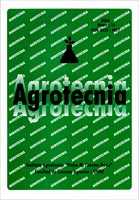Evolución del estado sanitario en colmenas de Apis mellifera L. bajo distinas condiciones de manejo y su relación con el aporte nutricional del polen
DOI:
https://doi.org/10.30972/agr.0326339Palabras clave:
Abeja, Varroa, Nosema, contenido proteico, nordeste argentinoResumen
La apicultura del Nordeste Argentino posee un desarrollo promisorio, debido a las condiciones favorables de la región. Las colonias de Apis mellifera L. son afectadas por diferentes estresores bióticos entre los cuales se encuentra el ácaro Varroa destructor y el microsporidio Nosema sp., que pueden afectar gravemente la salud de las abejas y disminuir la producción de la colmena. El estado nutricional de las abejas puede estar influenciado por el polen pecoreado y el contenido proteico de las especies visitadas por las abejas. El estudio se llevó a cabo en el apiario de la Escuela de la Familia Agrícola “Tupá Rembiapo”. Seis colmenas fueron asignadas al grupo “tratamiento”, se aplicó por única vez un acaricida orgánico a base de ácido oxálico, y cinco al grupo “control”. Se realizaron muestreos mensuales (octubre/2020 - abril/2021). Se utilizó el método del frasco para evaluar prevalencia de varroa en estado forético. Al mismo tiempo, se tomaron muestras de abejas retornantes para evaluar nosema. Se obtuvieron muestras de cargas corbiculares con trampas caza polen, se realizó el análisis cualitativo con técnicas de microscopía y se determinó nitrógeno total (método Kjeldahl). En las colmenas tratadas, la población de Varroa disminuyó en los muestreos inmediatos post tratamiento y en el grupo control la dinámica de la parasitosis fue variable, con rangos de infestación de 0,74% a 6,71%. El registro de esporas de Nosema sp. estuvo bien marcado en primavera y otoño. A pesar de esto no se observa sintomatología asociada a la Nosemosis que indique riesgos y desarrollo de la enfermedad en la zona. En cuanto al polen acopiado, predominaron las especies nativas (81%) sobre las exóticas (19%). Los mayores volúmenes fueron recolectados en primavera (octubre) y las especies dominantes fueron Senecio grisebachi y Enterolobium contortisiliquum. En verano (enero) predominó Schinopsis balansae y en otoño (abril) aumentó la diversidad específica, pero disminuyó el volumen total. En cuanto al contenido de proteína bruta se determinó un rango de 11% a 21,5%.



